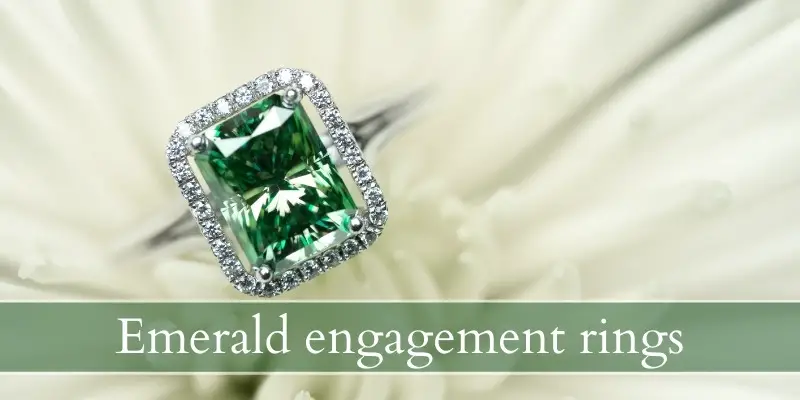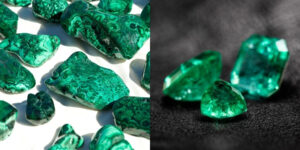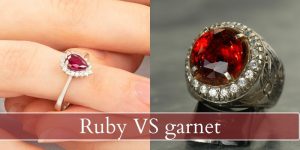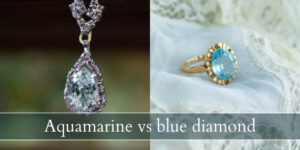Emerald engagement rings are less common than sapphire and ruby engagement rings, but they have a certain beauty that can’t be denied. It may be the deep green color of an emerald, or its association with mystical and magical people, but it’s definitely an eye-catching gemstone.
Maybe you or your loved one really want a green stone for the engagement ring. Am emerald fits the bill perfectly, so let’s talk about what these engagement rings mean, and how to make sure you get a good emerald.

Emerald engagement ring meaning
Emerald engagement rings represent peace, growth, rebirth, and also inspire an air of nobility. In general, deep, lush hues of emerald are associated with nobility, regardless of who is wearing them. And through as association with pop culture and media, emeralds may remind some people of magic, mysticism, and spiritualism.
An emerald engagement ring is nothing to sneeze at, especially when mounted on a yellow gold band, or even rose gold. The colors complement the emerald beautifully, and manage to make the gemstone pop even more.
Famous emerald engagement rings belong to Jackie Kennedy, Zoe Saldana, Halle Berry, Olivia Wilde, among others.
Is emerald ok for an engagement ring ?
Yes, emerald is great for an engagement ring though care must be take as this gemstone is ore fragile than others. An emerald ranks 7.5-8 on the Mohs scale of hardness, meaning it’s fairly tough but may scratch or chip with everyday use. That’s just how emeralds are. Gemstones are considered safe for everyday wear if they rank at least 7.0 on the Mohs scale.
Due to emerald slightly fragile structure and how prone it is to inclusions, many jewelers would recommend a protective setting for an emerald ring. This affects the overall design more than you think. For example a bezel setting is the most protective one, and a halo setting would be next. Any exposed side in an emerald are a liability, more than in a diamond or sapphire.
So choose your setting and gemstone cut with care.
Emerald is May’s birthstone
Emerald is May’s birthstone. This would make for a very beautiful engagement ring for a lovely person born in May, or if you’re proposing in May.
Or, it could be a beautiful ring for someone who is Irish, or of Irish descent. While emeralds are not necessarily mined in Ireland, the island has been called the Emerald Isle due to its rolling green hills, lush with grass and a deep, beautiful green.
Read also: Sapphire Engagement Ring Meaning
Are emeralds bad luck ?
No, emeralds are not bad bad luck in and of themselves. Their green color may be associated with envy, which may lead some people to think an emerald will attract someone’s unwanted attention and thus attract bad luck.
This is, of course, not true as any gemstone can attract envy due to how expensive and exquisite it is, whether it’s an emerald or not. So don’t worry about your emerald engagement ring. It won’t attract more bad luck than a diamond, sapphire, or any other gem in the world.
How much is a 2 carat emerald ?
An emerald is valued first for its color, and then for its clarity. This is reflected in the final price per carat, as two stones of the same carat but of different colors or clarity will have vastly different price tags.
For example a 2.1 carat oval emerald of natural origin, standard treatment, intense green color, and very slightly included can go for $18,600 on GemsNY.
Another emerald, this one 2.06 carats and with an intense green color but moderately included goes for far less, at $5,400 also on GemsNY. This emerald is also subjected to standard treatment such as oiling or filling with resin, but even so the clarity hasn’t improved enough to make it as expensive as the other one.
So your emerald can vary in price depending on its color and clarity. If you find a lab-grown emerald you’ll notice the prices are much lower than for a natural emerald, even one that isn’t treated.
What to know when buying an emerald engagement ring
When you’re off to buy an engagement ring you should remember that you’re looking for the gem first, and then the setting of the ring. The setting can always be changed, but the stone is what you or your fiancee will be wearing (hopefully) forever. It has to be a great emerald.
If you’ve never bought a gemstone before you should take a look at these pointers.
Most emeralds on the market are oiled or filled
When buying an emerald you’ll be faced with many, many options, all of them beautiful in their own way. You may notice most of them say ‘treated’ or ‘oiled’, and it’s pretty hard to find one that isn’t.
Emeralds are fairly fragile, due to their nature. They have imperfections within the crystal, meaning they can easily fracture and break along the line where those imperfections are. Some imperfections may be removed or improved with heat treatments, but most can’t.
This is where oiling or filling the emerald comes in. These processes serve the same purposes:
- achieve a temporary better clarity in the gemstone
- fill any tiny gaps or cracks within the gem
- improve color, if colored oil or resin is used
Oiling is usually done with cedar oil, as it has a refractive index very similar to emeralds. The emerald is injected with the oil and has a bit of it rubbed on the surface. Like cream on dry, cracked hands, the oil seeps into the cracks. The emerald doesn’t soften but its appearance is dramatically improved.
Filling may be done with glass or Opticon, a synthetic material or resin. The principle is the same, meaning the filling will improve clarity and fill any cracks. But, it may also hold the emerald together better, as it can act as a binding agent.
Both treatments may fail in time. The resin or glass may yellow in time, the oils will slowly seep out of the emerald the more you wash or expose it to sun and water and light.
Your options ? Accept an oiled or filled emerald, or buy a synthetic emerald.
Synthetic emeralds are more stable and affordable
Because emeralds are so darn fragile, synthetic ones that are lab-grown have come up to provide a more stable version. This means the emeralds have much better clarity and their crystal structure is pretty stable.
Of course, they are not a natural emerald and for some this can be a deal breaker. In this case you have to ask yourself whether you want an emerald for its rarity and glamour, or you simply want a green stone.
A true emerald is impressive but requires more care than other gemstones. For an ring that will be worn every day, an emerald may be a bit risky if not set in a bezel. A synthetic emerald will get you a lower cost and better stability. And if it ever breaks, it’s cheaper to replace than a natural emerald.
The best and safest cut for an emerald is emerald
Emeralds come in various cuts and shapes, but the safest and most stable for for an emerald is the emerald cut. Due to an emerald’s crystal habit of growing in long 6 sided cylinders, much like an amethyst, the easiest way to yield a good emerald is to cut it according to that shape.
So an emerald cut, a rectangular cut from above and a triangle cut from the side, offers the most stability without ruining the crystal structure. The 4 corners are cut off, as leaving them exposed would simply invite fractures.
Unlike a diamond, an emerald doesn’t sparkle as much. it simply can’t, because it doesn’t have as high a refractive index and it’s never going to be as clear as a diamond. This means there are many things getting in the way of light beams, so a brilliant cut 0with many sides – is not going to sparkle as much for an emerald.
A simpler cut such as emerald, Asscher, trillion, French, or princess are going to showcase an emerald’s color much better than other cuts. A cut that is too deep won’t allow enough light into the gem to show color.
Ask for a certificate for your emerald
When buying your emerald, whether it’s already mounted on a ring or not, you should ask for a certificate. It should state the gem’s country of origin, whether it’s natural or lab-grown, any treatments it’s had, its cut, color grade, clarity, etc.
Do this, because the gem trade can be a shady business and gems pass through a lot of hands before they reach yours. In some unfortunate cases you may be sold a different gemstone of the right color. The most common emerald dupes are tsavorite (green garnet), chrome tourmaline, green cubic zirconia.

I’m the main author for jewelrymaterialguide.com. I started this site after we did tons of research before our wedding and noticed that there is information about rings, jewelry, and so on that is really hard to find on the internet.






